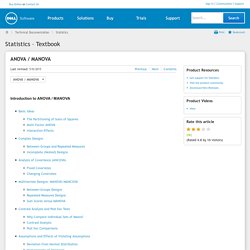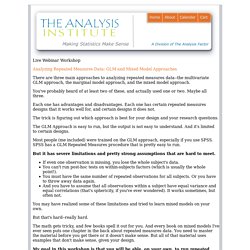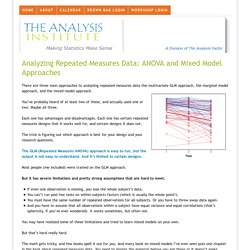

Repeated Measures Analysis of Variance: NCSS. ANOVA / MANOVA - Statistics Textbook. A general introduction to ANOVA and a discussion of the general topics in the analysis of variance techniques, including repeated measures designs, ANCOVA, MANOVA, unbalanced and incomplete designs, contrast effects, post-hoc comparisons, assumptions, etc.

For related information, see also Variance Components (topics related to estimation of variance components in mixed model designs), Experimental Design/DOE (topics related to specialized applications of ANOVA in industrial settings), and Repeatability and Reproducibility Analysis (topics related to specialized designs for evaluating the reliability and precision of measurement systems). See also, General Linear Models and General Regression Models; to analyze nonlinear models, see Generalized Linear Models. Basic Ideas The Purpose of Analysis of Variance In general, the purpose of analysis of variance (ANOVA) is to test for significant differences between means.
Why the name analysis of variance? More introductory topics: Analyzing Pre-Post Data with Repeated Measures or ANCOVA. Not too long ago, I received a call from a distressed client.

Let’s call her Nancy. Nancy had asked for advice about how to run a repeated measures analysis. The advisor told Nancy that actually, a repeated measures analysis was inappropriate for her data. Nancy was sure repeated measures was appropriate and the response led her to fear that she had grossly misunderstood a very basic tenet in her statistical training. The Design Nancy had measured a response variable at two time points for two groups: an intervention group, who received a treatment, and a control group, who did not. Both groups were measured before and after the intervention. The Analysis Nancy was sure that this was a classic repeated measures experiment with one between subjects factor (treatment group) and one within-subjects factor (time).
The advisor insisted that this was a classic pre-post design, and that the way to analyze pre-post designs is not with a repeated measures ANOVA, but with an ANCOVA. Stnews77. The Analysis Institute - Making Statistics Make Sense. Live Webinar Workshop Analyzing Repeated Measures Data: GLM and Mixed Model Approaches There are three main approaches to analyzing repeated measures data--the multivariate GLM approach, the marginal model approach, and the mixed model approach.

You've probably heard of at least two of these, and actually used one or two. Maybe all three. Each one has advantages and disadvantages. The trick is figuring out which approach is best for your design and your research questions. The GLM Approach is easy to run, but the output is not easy to understand. Most people (me included) were trained on the GLM approach, especially if you use SPSS. But it has severe limitations and pretty strong assumptions that are hard to meet. If even one observation is missing, you lose the whole subject's data. You may have realized some of these limitations and tried to learn mixed models on your own. But that's hard--really hard. The math gets tricky, and few books spell it out for you.
In the Workshop, you will learn: Repeated-Measures and Two-Factor Analysis of Variance. Using repeated measures anova with spss. Sample size for repeated-measures t-test - Research Engineer. Repeated Measures: LinkedIn Expertise. SAS: Power and Sample Size for Repeated Measures, 2014. RepeatedMeasures. One Way repeated measures ANOVA D. Boduszek. Analyzing Repeated Measures Data: ANOVA and Mixed Model Approaches - The Analysis Institute.
There are three main approaches to analyzing repeated measures data–the multivariate GLM approach, the marginal model approach, and the mixed model approach.

You’ve probably heard of at least two of these, and actually used one or two. Maybe all three. Each one has advantages and disadvantages. Each one has certain repeated measures designs that it works well for, and certain designs it does not. The trick is figuring out which approach is best for your design and your research questions. The GLM (Repeated Measures ANOVA) approach is easy to run, but the output is not easy to understand.
Most people (me included) were trained on the GLM approach. But it has severe limitations and pretty strong assumptions that are hard to meet. If even one observation is missing, you lose the whole subject’s data.You can’t run post-hoc tests on within-subjects factors (which is usually the whole point!). You may have realized some of these limitations and tried to learn mixed models on your own. New View of Statistics: Repeated Measures - 2. SPSS Examples: ANOVA, MANOVA. Andy Fields: Repeated Measures. MANOVA: Gregory Carey.